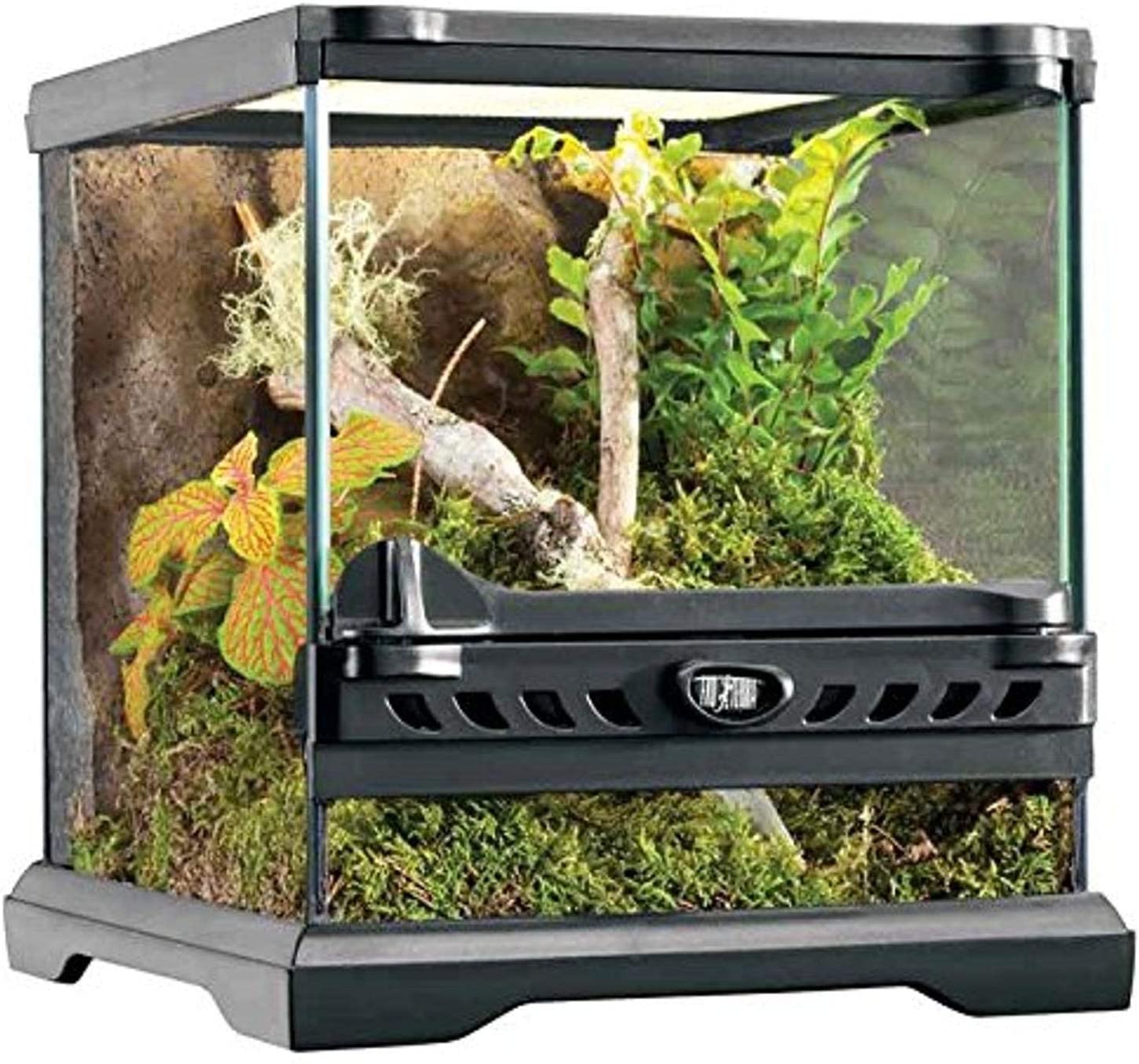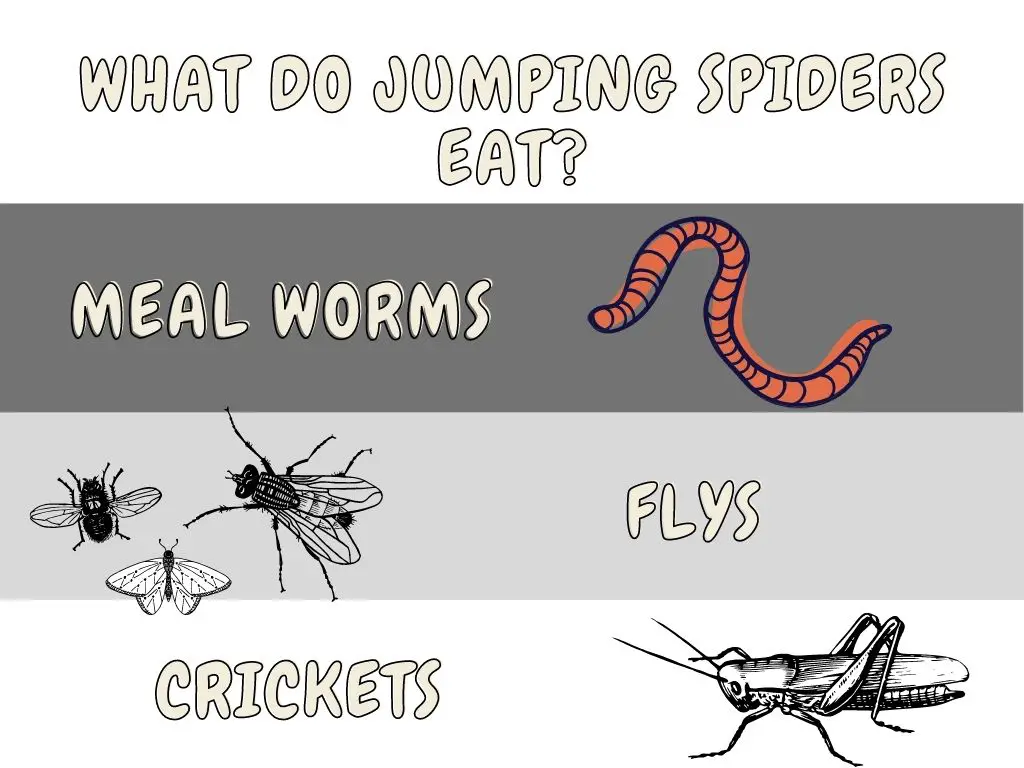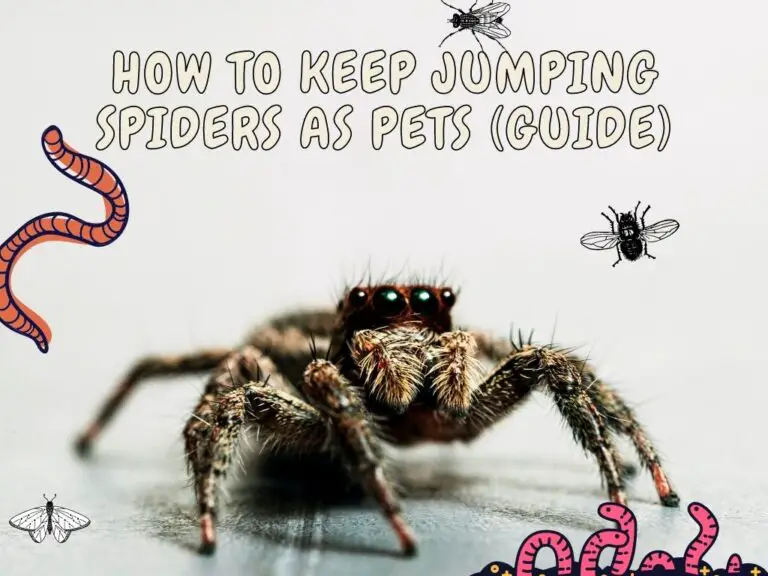Jumping spiders have earned a reputation for being the best jumpers in the spider clan. This unique skill has made them great hunters as well as increasing their chances of escaping from danger.
Because they are carnivorous in nature, jumping spiders are known to hunt and eat smaller prey. Sometimes, they even go for insects that are twice their size.
In addition to their impeccable jumping and hunting skills, these little leapers have excellent eyesight and senses. This gives them an edge and pushes them up the food chain within their habitat.
So besides being darn too cute, our fuzzy friends are excellent hunters that easily catches the eye of exotic pet lovers. This explains why more people are looking to own exotic animals like jumping spiders as pets. From their cuteness to their animosity, these intelligent creatures are a joy to behold.
But here is the real deal…
Although jumping spiders are cute, friendly, and everything in between, they have quite a short lifespan. From their young to adult life, these creatures only shed about 5-6 times. Plus, their total lifespan is about one to three years.
So before getting excited about keeping a jumping spider as a pet, it’s best to know more facts about them, along with requirements to raise a healthy and happy jumping spider.
At the end of the day, what matters is being a responsible exotic pet owner.
In today’s article, we will give you all the information you need to help you understand how to raise your fuzzy friends as pets.
How safe are jumping spiders as pets?
Although jumping spiders are friendly and harmless to humans, in the wild, these fuzzy creatures are vicious predators who can take out their prey with the help of their lethal venoms and precision jump.
That said, in front of humans, jumping spiders tend to shy away quickly. This explains why you can easily handle and play with them using your bare hand.
The cool thing about jumping spiders is that their main diets are made up of insects you probably hate.
Now, the big question is, are jumping spiders poisonous? Well, let’s bring you up to speed, shall we?
There are a lot of misconceptions and misunderstandings about our fuzzy friends. The first impression most people have about spiders is that they are poisonous.
While it is true that most spiders are venomous, the fact remains that only 30 to 40 out of the over 40,000 species of spiders have venom that is lethal enough to threaten humans.
Sure, jumping spiders are known to carry venom, but guess what? Their venom does little or nothing to humans.
Their venom is designed to incapacitate their prey before devouring them. And because they don’t usually spin webs like other traditional spiders, they rely on their precision jumps to take out their prey.
We won’t lie; getting bitten by a jumping spider can be painful, and sometimes it may leave redness and irritation that linger for days. But guess what, it doesn’t get any worse than this as you’ll feel better after a day or two.
Jumping spider housing setup
Our spider friends don’t require a beautiful home or enormous tank to thrive very well. As a matter of fact, some jumping spiders are relatively small, that they do very well in small spaces. So, if you’ve been worried about getting a big house for your exotic pet, you can rest assured that getting something small wouldn’t be such a bad idea.
Some jumping spider housing idea:
- Substrate
- Container
- Shelters and hideouts
When it comes to getting creative and building suitable housing for your spider friend, keep in mind that the type of container that you use doesn’t really matter. So long it has enough holes for air ventilation; it should work just fine.
That said, also ensure that the container is a bit spacious. The truth is, you want to give them enough room to wander just like they do in their natural habitat.
To this end, you can build a DIY jumping spider enclosure using a container measuring one cubic foot in size. And for those who don’t know, a one cubic foot container is equal to a 7-gallon tank. That’s more than enough space for your jumping spider to roam around freely.
If you’re not very picky, then a sizeable Kritter keeper from Amazon or a simple medium Kritter enclosure should work just fine. Alternatively, you can go for small acrylic fish tanks. They also get the job done pretty well.
Another thing you don’t want to leave out is to make sure your preferred container has a lid or cover. With a top or cover, your fuzzy friend is safe and will not run wild. It will also be a good idea to use a mesh lid or something with holes on it. This allows for extra ventilation.

Can you have more than one jumping spider in the same enclosure?
This is one question we get asked a lot, and today, we want to set the record straight. Having more than one spider in a single enclosure is a recipe for disaster.
If they are kept together in isolation, it is only a matter of time before they eat each other.
Each jumping spider should have its enclosure except for breeding purposes. When breeding, it’s okay to put a female and a male within the same enclosure.
But here is the catch.
If you leave them together for too long, there is every likelihood that the female will devour the male. So only leave them in the same tank for a couple of days when trying to mate them. After a couple of days, you can take them back to their respective enclosures.
Where should you keep your enclosure or tank?
Jumping spiders like a lot of sunlight. So, do well to place their enclosure somewhere close to the window or areas within your home with enough natural light as they like to stay warm.
But make sure you don’t expose them to too much sunlight for a long time. If not, they may eventually get baked alive, and we doubt you’ll like that very much.
What do jumping spiders feed on?
Our fuzzy friends eat almost all kinds of insects. From crickets to flies to roaches to moths and more, jumping spiders eat insects that a smaller than them. Not just that, they also devour insects that are a lot bigger than them.
In the wild, jumping spiders are known to feed on nectar from flowers. This explains why some people think that some species of jumping spiders are vegetarians.

That said, here is a list of insects you can offer to your spider friend:
Crickets
Jumping spiders love crickets, and they never say no to this fantastic food. As a matter of fact, crickets are the number one food choice for jumping spiders. Thankfully, crickets can be found almost everywhere, so you can catch them on your own.
However, if you think this is too big a job, you can buy them at pet stores close to you or order them online. Here, check out some pros and cons of offering crickets to your exotic pet.
Pros
- You can easily catch them.
- They are cheap and readily available.
- Can be cultivated
Cons
- Because crickets are large, they can end up biting your spider.
Mealworms
Mealworms are yet another incredible alternative food to offer your jumping spider. The cool part is that it can be gotten from pet stores around you or ordered online. Read on to see some pros and cons of offering mealworms to your spider friend.
Pros:
- They are readily available and can be gotten from stores around you.
- They can be cultivated.
Cons
- Leftover mealworms should be cleared off, or they may turn into beetles.
Flies
One cool thing about this food for jumping spiders is that they are readily available and can be gotten from your kitchen during any season. Sure, they aren’t so easy to catch but guess what, you can get them from pet stores close to you. Here are some pros and cons of offering flies to your spider friend.
Pros:
- They are readily available and can be caught around the home.
- Spiders never say no to a meal of edible flies.
- It can be easily purchased from pet stores around you.
- You can even refrigerate them, so you have a steady supply you can offer to your spider friend.
Cons:
- Flies can lay eggs that may end up turning into maggots if they aren’t refrigerated.
- They are not so easy to catch.
As far as their meals are concerned, jumping spiders are not high maintenance. Also, you can easily self-cultivate or catch their prey if you’re on a budget.
How do you feed jumping spiders?
Feeding your fuzzy friend isn’t such a difficult task. We will run you through everything you need to know about that in a bit.
To start with, you can either drop their favorite prey directly into their container or offer their food to them using tweezers or your hands if you aren’t too nervous around spiders.
What is their frequency of feeding?
In terms of feeding frequency, it can be quite tricky to get things right. But we are here to make things simple. For adult jumping spiders, it’s okay to feed them every 2 to 3 days. And most times, when they are full, they tend to walk away or just ignore the food.
If you are raising spiderlings or juvenile spiders, try to feed them every 2 to 3 days as they tend to get hungry more often. Also, try to keep juvenile spiders apart, or they may end up eating each other.
For much older jumping spiders, they tend to eat less and may sometimes go a month without food. Also, at this stage, they prefer dead food as they no longer hunt for food.
Do jumping spiders drink water?
Just like humans, spiders like to drink water every now and then. However, you need to serve water in moderation or risk drowning them.
Fun fact:
Our fuzzy friends have lungs that look like pages of a book. This explains why their lungs are referred to as book lung. Because of the design of their lungs, they tend to drown very easily.
To make sure your spider friend doesn’t drown when offering it water, here are some things you can do
- Get a turkey baster and drop a few droplets of water every week in the corner of their enclosure.
- Alternatively, you can use a spray bottle to mist a section of the enclosure. Make sure it is away from the spider.
Click here for more interesting facts about jumping spiders
Frequently asked questions
Can you tame a jumping spider?
If what you want is a cuddly exotic pet, then look elsewhere. While they are friendly, non-aggressive and rarely bite humans, these creatures are not very easy to handle. Plus, they can leave a painful sting if they feel threatened. While their bite may not cause a lot of damage, it may leave you with redness and irritation that linger for days.
How long do jumping spiders live for?
Jumping spiders generally have a short lifespan. And depending on their species and sex, they can survive for 6 months to 3 years. Also, keep in mind that the males don’t survive as long as the females.
Can jumping spiders bite?
Thanks to their fangs, jumping spiders can bite and produce venom. Thankfully, their venom doesn’t hurt humans. And while they can bite, you may only experience redness and irritation that fades away after a couple of days.
To this end, jumping spiders aren’t considered dangerous.
Conclusion
From feeding to getting a befitting enclosure for your fuzzy friend, raising jumping spiders isn’t so difficult. Plus, it wouldn’t cost you so much. So, if you’re worried that you may dig too deep into your savings to effectively raise your exotic pet, rest assured that it won’t cost you so much.
Also, the fact that you can self-cultivate and catch their prey makes your job easy.




